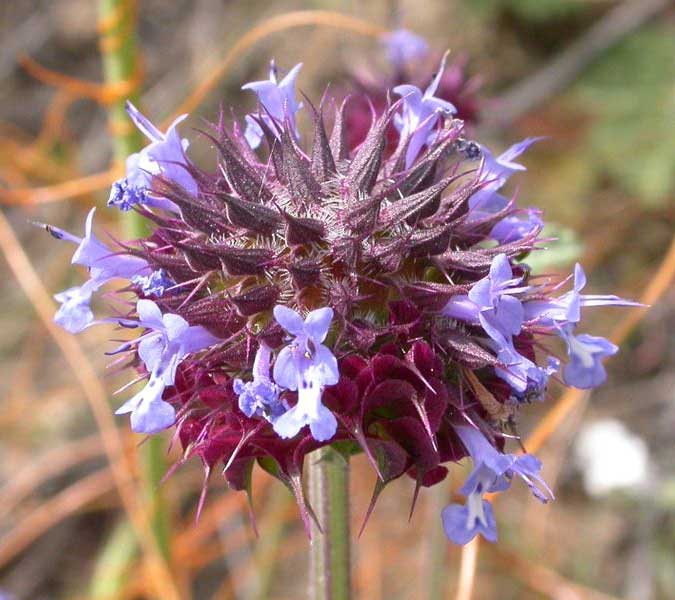
Salvia columbariae (Photo: *)
Classification System: APG IV
Superregnum: Eukaryota
Regnum: Plantae
Cladus: Angiosperms
Cladus: Eudicots
Cladus: Core eudicots
Cladus: Asterids
Cladus: Lamiids
Ordo: Lamiales
Familia: Lamiaceae
Subfamilia: Nepetoideae
Tribus: Mentheae
Subtribus: Salviinae
Genus: Salvia
Subgenus: S. subg. Sclarea
Sectio: S. sect. Echinosphace
Species: Salvia columbariae
Varieties: S. c. var. argillacea – S. c. var. columbariae
Name
Salvia columbariae Benth., 1833
Synonyms
Homotypic
Pycnosphace columbariae (Benth.) Rydb., Fl. Rocky Mts.: 747 (1917).
Distribution
Native distribution areas:
References
Primary references
Bentham, G. 1832–1836. Labiatarum genera et species: or, a description of the genera and species of plants of the order Labiatae; with their general history, characters, affinities, and geographical distribution. LXVIII + 783 pp. James Ridgway and Sons, London. Gallica Biblioteca Digital Reference page. : 302.
Additional references
Govaerts, R.H.A. 2003. World Checklist of Selected Plant Families Database in ACCESS: 1-216203. The Board of Trustees of the Royal Botanic Gardens, Kew. [unavailable for the public] Reference page.
Links
Govaerts, R. et al. 2022. Salvia columbariae in World Checklist of Selected Plant Families. The Board of Trustees of the Royal Botanic Gardens, Kew. Published online. Accessed: 2022 May 09. Reference page.
Hassler, M. 2022. Salvia columbariae. World Plants: Synonymic Checklists of the Vascular Plants of the World In: Roskovh, Y., Abucay, L., Orrell, T., Nicolson, D., Bailly, N., Kirk, P., Bourgoin, T., DeWalt, R.E., Decock, W., De Wever, A., Nieukerken, E. van, Zarucchi, J. & Penev, L., eds. 2022. Species 2000 & ITIS Catalogue of Life. Published online. Accessed: 2022 May 09. Reference page.
Tropicos.org 2022. Salvia columbariae. Missouri Botanical Garden. Published online. Accessed: 09 May 2022.
International Plant Names Index. 2022. Salvia columbariae. Published online. Accessed: May 09 2022.
Vernacular names
čeština: Šalvěj kalifornská
Deutsch: Kalifornische Chia
English: chia sage
íslenska: Dúfnasalvía
മലയാളം: സാൽവിയ കൊളംബേറിയ
Salvia columbariae is an annual plant that is commonly called chia, chia sage, golden chia, or desert chia, because its seeds are used in the same way as those of Salvia hispanica (chia). It grows in California, Nevada, Utah, Arizona, New Mexico, Sonora, and Baja California,[2] and was an important food for Native Americans. Some native names include pashiiy from Tongva and it'epeš from Ventureño.
Description
The inflorescence usually consists of one or two clusters. Bracts are about 10 mm (0.39 in), more or less round and tipped with an awn (bristle).
Salvia columbariae grows 10 to 50 cm (3.9 to 19.7 in) tall. Its stem hairs are generally short and sparse in distribution. It has oblong-ovate basal leaves that are 2 to 10 cm (0.79 to 3.94 in) long. The leaves are pinnately dissected and the lobes are irregularly rounded. The inflorescence is more or less scapose, meaning it has a long peduncle that comes from the ground level that has bracts. The bracts are round and awn-tipped. There are usually 1–2 cluster of flowers within the inflorescence. The calyx is 8 to 10 mm (0.31 to 0.39 in) long and the upper lip is unlobed but has 2 (sometimes 3) awns. The lower lip is about twice the size of the upper lip. The flower color can be pale blue to blue and purple tipped. The stamens of the plant are slightly exserted. The fruit of S. columbariae is a nutlet that is tan to grey in color and 1.5 to 2 mm (0.059 to 0.079 in) long.[1]
Varieties
Salvia columbariae var. columbariae Benth. – California sage, chia
Salvia columbariae var. ziegleri Munz – Ziegler's sage[3]
Habitat
Salvia columbariae can be found in dry undisturbed sites, chaparral, and coastal sage scrub. It generally grows at elevations lower than 2,500 m (8,200 ft). In cultivation, it prefers good drainage, sun, and dry weather.[1]
Uses
Medicinal uses
The Cahuilla used the columbariae Benth. variety as a disinfectant by grinding the seeds to mush and applying it to infections as a poultice.[4][5] The Cahuilla, Ohlone, Kawaiisu, and Mahuna used the gelatinous seeds to cleanse out foreign matter in the eyes. The seeds were placed in the eyes for infections and inflammation, and during sleep, they were tucked underneath the eyelids to remove sand particles.[5] The Ohlone also used it to reduce fevers by consuming the seeds, and the Diegueno chewed the seeds on journeys by foot to give strength.[5]
Food
The Cahuilla, Kawaiisu, Mohave, Tohono O'odham, Chumash and Akimel O'odham grind the seeds and mixed it into water to make a thick beverage. The Cahuillas removed the alkali salts in the water, improving the flavor. They also dry the seeds to make cakes or mush. The Ohlones, Mohave, and Pomo make pinole. The Diegueno added the seeds to wheat to improve flavor. The Mahuna, Paiute, and Akimel O'odham make it into a gelatinous material, then cook it into porridge. The Luiseno, Tubatulabal, and Yavapai used it extensively as a food source.[5]
Building material
The Mahuna made it into a fiber and covered their dwellings.[5]
References
"Salvia columbariae". in Jepson Flora Project (eds.) Jepson eFlora. Jepson Herbarium; University of California, Berkeley. 2018. Retrieved 2018-07-06.
Sullivan, Steven. K. (2018). "Salvia columbariae". Wildflower Search. Retrieved 2018-07-06.
Salvia columbariae. ITIS.
"Temalpakh Ethnobotanical Garden". malkimuseum.org. Archived from the original on 2008-05-15. Retrieved 2007.
"Salvia columbariae Benth". herb.umd.umich.edu.
Retrieved from "http://en.wikipedia.org/"
All text is available under the terms of the GNU Free Documentation License

